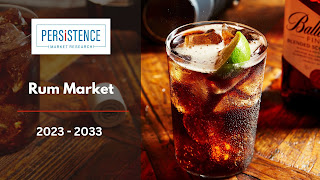- Get link
- X
- Other Apps
- Get link
- X
- Other Apps
Market Overview
Rum, a distilled
alcoholic beverage made from sugarcane byproducts such as molasses or directly
from sugarcane juice, has a rich history dating back centuries. From its
origins in the Caribbean to becoming a global favorite, rum has evolved in
taste, production, and consumer preferences. As we embark on the journey into
the next decade, understanding the current state and projected trends of the
rum market is paramount for producers, distributors, and enthusiasts alike.
The global rum
market has experienced steady growth over the past decade, driven by several
factors including increasing consumer interest in premium and artisanal
spirits, expanding cocktail culture, and the emergence of new markets. According to Persistence Market Research's
projections, the global rum
market is projected to grow steadily, with a CAGR of 3.9%, rising from a
market value of $17.6 billion in 2023 to an estimated $35.5 billion by 2033.
This growth is driven by factors such as changing consumer preferences,
evolving cocktail culture, and increasing demand for premium spirits.
Key Drivers of Growth
Shifting Consumer
Preferences: Today's consumers are more discerning and adventurous in their
drinking habits, seeking out unique flavors and experiences. This trend has
fueled the demand for premium and craft rums, as consumers explore different
varieties and brands beyond traditional offerings.
Cocktail Culture:
The rise of cocktail culture, driven by the proliferation of cocktail bars,
mixology competitions, and social media influencers, has significantly
contributed to the growth of the rum market. Rum's versatility as a base spirit
for a wide range of cocktails, from classic Mojitos to innovative tiki
concoctions, has made it a favorite among bartenders and consumers alike.
Market Expansion:
While traditional rum-consuming regions such as the Caribbean and Latin America
continue to dominate the market, there has been significant growth in emerging
markets such as Asia-Pacific and Africa. Increasing disposable incomes,
changing lifestyles, and growing tourism have spurred demand for rum in these
regions, presenting lucrative opportunities for market expansion.
Premiumization:
The trend towards premiumization, characterized by consumers trading up to
higher-priced and higher-quality products, has reshaped the rum market
landscape. Premium and ultra-premium rum segments have experienced robust
growth, driven by the demand for aged and limited-edition expressions, as well
as the perception of rum as a sophisticated and premium spirit.
Sustainability and
Ethical Consumption: With increasing awareness of environmental and social
issues, consumers are gravitating towards brands that prioritize
sustainability, ethical sourcing, and corporate responsibility. Rum producers
are responding by adopting sustainable practices such as eco-friendly
packaging, fair trade certifications, and community initiatives, appealing to
conscientious consumers.
Read More: https://www.persistencemarketresearch.com/market-research/rum-market.asp
Challenges and Opportunities
While the rum
market presents promising growth prospects, it also faces several challenges
and opportunities that will shape its trajectory in the next decade.
Competition from
Other Spirits: Despite its popularity, rum faces stiff competition from other
spirits such as whiskey, vodka, and tequila. To maintain its market share and
attract new consumers, rum producers must differentiate their products through
innovation, marketing, and strategic partnerships.
Regulatory and
Taxation Issues: Regulatory hurdles and taxation policies vary across regions
and can significantly impact the production, distribution, and pricing of rum.
Producers must navigate complex regulatory landscapes while advocating for
policies that support the growth of the rum industry.
Brand Authenticity
and Storytelling: In an increasingly crowded market, building authentic brand
narratives and engaging storytelling is crucial for connecting with consumers
on an emotional level. Brands that can convey their heritage, craftsmanship,
and unique flavor profiles effectively are better positioned to resonate with
consumers and command premium prices.
Innovation and
Product Development: Continued innovation in product development, packaging,
and marketing strategies is essential for driving growth and staying ahead of
evolving consumer trends. Whether it's experimenting with new aging techniques,
introducing flavored rums, or leveraging technology for interactive brand
experiences, innovation will be key to capturing consumers' attention and
loyalty.
Global Economic
Uncertainty: Economic volatility, geopolitical tensions, and unforeseen global
events can have a significant impact on consumer spending habits and market
dynamics. Rum producers must remain agile and adaptable to navigate
uncertainties and mitigate risks while seizing opportunities for growth in both
established and emerging markets.
The rum market is
poised for continued growth and evolution in the coming decade, driven by
shifting consumer preferences, expanding markets, and industry innovation.
While challenges such as increased competition and regulatory complexities
persist, opportunities abound for brands that can leverage authenticity,
innovation, and sustainability to capture the hearts and palates of consumers
worldwide. By understanding and adapting to emerging trends and market
dynamics, stakeholders in the rum industry can chart a course for success in
the next decade and beyond.
Follow Us: LinkedIn | Medium | Twitter | Tumblr
About
Persistence Market Research:
Business intelligence is the foundation of every business model employed
by Persistence Market Research. Multi-dimensional sources are being put to
work, which include big data, customer experience analytics, and real-time data
collection. Thus, working on “micros” by Persistence Market Research helps
companies overcome their “macro” business challenges.
Persistence Market Research is always way ahead of its time. In other
words, it tables market solutions by stepping into the companies’/clients’
shoes much before they themselves have a sneak pick into the market. The
pro-active approach followed by experts at Persistence Market Research helps
companies/clients lay their hands on techno-commercial insights beforehand, so
that the subsequent course of action could be simplified on their part.
Contact Us:
Persistence Market Research
G04 Golden Mile House,
Clayponds Lane, Brentford, London,
TW8 0GU UK
Email: sales@persistencemarketresearch.com
Web: https://www.persistencemarketresearch.com
- Get link
- X
- Other Apps

Comments
Post a Comment